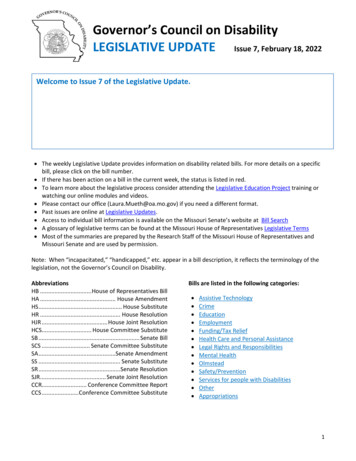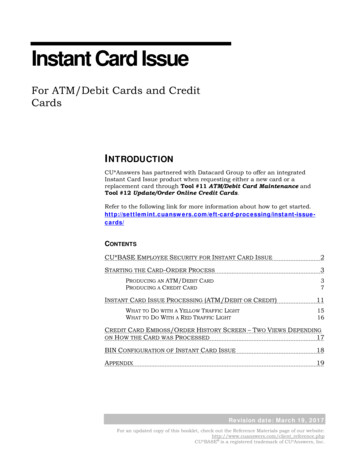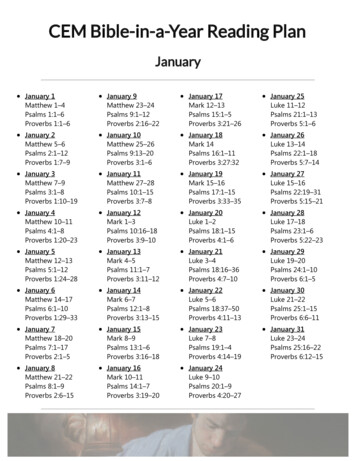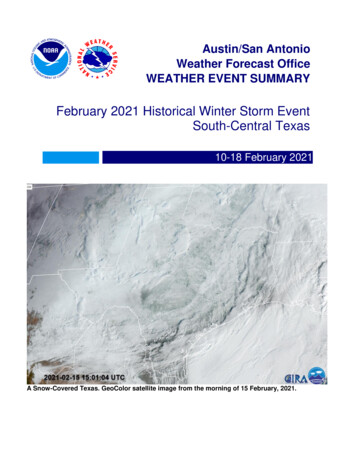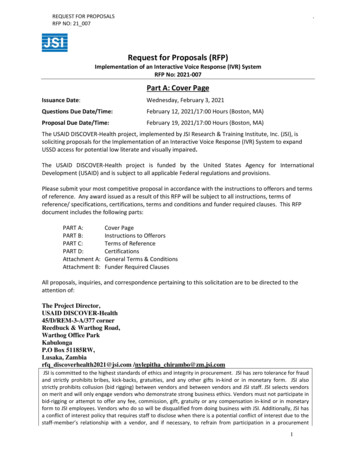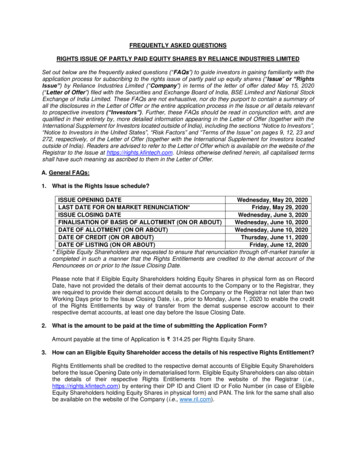
Transcription
BioCAPIssue 10February 2021Biodiversity Capacity Development UpdateThe CBD Secretariatmarks the successfulimplementation of theShort-Term CapacityBuilding Action Plan(2017-2020)The Forest EcosystemRestoration Initiative(FERI) strengthenscapacities to restoreforests and otherecosystemsAboutCapacity developmentefforts contribute to theachievement of AichiBiodiversity Targets 9,11, 17, 19 and 20The Cartagena Protocolon Biosafety and itsSupplementary Protocolon Liability and Redressreach importantmilestones in 2020Ten years since itsadoption, the NagoyaProtocol on Access andBenefit-Sharing reflectson its implementationStepping up effortsfor the conservationand sustainable useof marine and coastalbiodiversityFERI fosters SMARTerecosystem restorationstrategies and actionsThe Japan BiodiversityFund enhances capacitybuilding support for theeffective implementationof the Convention onBiological Diversity andits Protocols12345678Short-TermAction cess ityRestorationrelated TargetsJapanBiodiversityFundBulletinBoard
The CBD Secretariat marks the successful implementation of the Short-Term Capacity-Building Action Plan(2017-2020)The adoption of the Short-Term Action Plan (20172020) to Enhance and Support Capacity-Buildingfor the Implementation of the Convention and itsProtocols by the UN Biodiversity Conference in2016 (COP Decision XIII/23) was an importantmilestone.It re-affirmed the need for a focused, integratedand coherent approach to capacity-building andtechnical and scientific cooperation in supportingthe implementation of the Convention and itsProtocols.Since January 2017, the CBD Secretariat,in collaboration with partners, facilitated theimplementation of over 100 capacity-buildingactivities outlined in the short-term action plan.These activities were implemented with generousfinancial contributions from various governmentsincluding Belgium, Canada, Denmark, theEuropean Union, Finland, France, Italy, Japan,Norway, Germany, Republic of Korea, Sweden,Switzerland and the United Kingdom of GreatBritain, among others.Overall, approximately 91% of the plannedactivities were successfully implemented and anumber of concrete results were achieved, andmultiple lessons learned.AboutSome of the lessons learned include the need todiversify the capacity delivery modalities (beyondtraining workshops) and the need to give dueattention to building capacities at other levels (i.e.organizational and/or enabling environment).It is also important to adopt a clear vision anda long-term programmatic approach to capacitydevelopment.Furthermore, financial considerations must beconsidered at the planning stage of the capacitybuilding interventions.Parties to the Convention and its Protocols willnegotiate the long-term strategic framework atthe next meeting of the Conference of the Partiesto be held in Kunming, China.More information on the preparation of the longterm strategic framework for capacity developmentas well as a list of capacity-building activitiesfacilitated by the Secretariat are available on thewebsite.It is also imperative to put in place mechanisms forfollow-up support and monitoring and evaluationframeworks for the capacity developmentinterventions.Lastly, relevant stakeholders must be involved inthe design and implementation of the interventionsto leverage their expertise and resources and toavoid duplication of efforts.The post-2020 period will require transformativeactions that move beyond “business as usual” anda strategic approach to capacity development. Inthis regard, a draft long-term strategic frameworkfor capacity development has been developed tosupport implementation of the post-2020 globalbiodiversity framework.12345678Short-TermAction cess ityRestorationrelated TargetsJapanBiodiversityFundBulletinBoard
Capacity development efforts contribute to the achievement of Aichi Biodiversity Targets 9, 11, 17, 19 & 20The fifth edition of the Global BiodiversityOutlook (GBO 5), which provides an update onthe progress made towards achieving the AichiBiodiversity Targets, noted that even though noneof the 20 Aichi targets have been fully achieved,important progress was made and capacitybuilding support was instrumental.Various cross-cutting capacity-building activities,supported by the CBD Secretariat, particularlycontributed to the implementation of AichiBiodiversity Targets 9, 11, 17, 19 and 20, whichaccording to GBO 5 are some of the few targetsthat have been partially attained.For example, the work on invasive alien species(IAS) and the development of management toolsand guidance, produced concrete results, suchas the Global Registry of Introduced and InvasiveSpecies (GRIIS), which have contributed toidentifying invasive species and managingpathways to prevent their introduction (as perAichi Target 9).Support was also provided to Parties of the CBDin different regions to strengthen cooperationand develop sustainable capacities to achieveAichi Target 11 on protected areas. Regionalimplementation support networks and coordinationmechanisms were established in Asia, the Pacificand Latin America to assist with implementationAboutof this target and to foster alignment and synergyamong various partners in each region. Varioussources of data on protected areas exist today,including the World Database on Protected Areas,which is accessible through the Protected PlanetInitiative, managed by UNEP-WCMC.Furthermore, the Secretariat in collaborationwith UNEP, UNDP and other partners, and withfunding from various donors, including the JapanBiodiversity Fund, provided ongoing technicalsupport for the revision and implementation ofnational biodiversity strategies and action plans(NBSAPs) in line with Aichi Target 17.In collaboration with partners, such as the UNDPBIOFIN, Parties were supported to developnational resource mobilization plans. An analysisof the available information shows that morecapacity development support is needed toscale-up efforts for reporting on resources beingmobilized for biodiversity.More information on the status of implementationof the Aichi Biodiversity Targets is available onthe website.Countries were supported in developing specificon-the-ground projects and activities to advancethe implementation of their NBSAPs.Lastly, with regards to Aichi Targets 19 and 20,the Secretariat also provided technical supportto facilitate and foster the exchange of scientificknowledge and technological developmentsrelevant to biodiversity through the clearinghouse mechanism.It also supported countries to use the financialreporting framework to assess and report on theavailability of financial resources for achievingtargets and progress in mobilizing internationalfinancial flows.12345678Short-TermAction cess ityRestorationrelated TargetsJapanBiodiversityFundBulletinBoard
The Cartagena Protocol on Biosafety and its Supplementary Protocol on Liability and Redress reachimportant milestones in 2020The year 2020 marked the 20th anniversary of theadoption of the Cartagena Protocol on Biosafetyas well as the 10th anniversary of the NagoyaKuala Lumpur Supplementary Protocol on Liabilityand Redress, which was adopted on 15 October2010 as an additional agreement to the Protocol.To date, 173 countries, including the EuropeanUnion, have become Parties to the CartagenaProtocol, while 48 Parties to the Protocol haveratified the Supplementary Protocol.The two instruments contribute to the conservationand sustainable use of biodiversity by ensuring anadequate level of protection in the safe transfer,handling and use of living modified organisms(LMOs) resulting from modern biotechnology.The development of capacities for the effectiveimplementation of these instruments hasbeen instrumental to reaching these importantmilestones.In line with the the short-term capacity-buildingaction plan (2017-2020) and further to Article22 of the Protocol, the CBD Secretariat hasfacilitated capacity-building support on variousissues. These include risk assessment, detectionand identification of LMOs, public awareness,education and participation regarding LMOs,integrated implementation and mainstreamingbiosafety, as well as the use of the BiosafetyClearing-house (BCH).AboutSeveral capacity-building materials and tools havebeen developed, with support from various donors,including a training manual on risk assessment, aninteractive toolkit on mainstreaming biosafety aswell as e-learning modules on the SupplementaryProtocol, mainstreaming biosafety, public accessto biosafety information and public participationin decision making processes regarding LMOs,among others.The Secretariat also implemented, with thesupport from the Japan Biodiversity Fund, aproject to strengthen capacities for mainstreamingbiosafety and the integrated implementation ofthe Protocol, the Supplementary Protocol and theConvention at the national level.As part of the project, small grants and technicalassistance were provided to 10 countries(Cambodia, Cameroon, Cuba, Ghana, Mongolia,Nigeria, Peru, Togo, Venezuela and Vietnam)to test practical actions and approaches tofoster integrated implementation of the threeinstruments.Each participating country organized nationalworkshops and seminars, and made use ofonline materials, resulting in the development ofnational mainstreaming strategies. Additionally,countries developed policy recommendationsfor the integration of biosafety concerns in theirnational biodiversity strategies and action plans,which contributed to Aichi Biodiversity Target 17.Moreover, the Secretariat continued to enhancethe capacity of countries to effectively participatein the BCH and facilitate the exchange of viewsand information on key elements, proceduresand practices of public education and publicawareness regarding LMOs. An educationalvideo was also developed highlighting theimportance of setting up systems for biosafetyeducation.Furthermore, the Secretariat embarked on thedevelopment of a draft implementation plan forthe Cartagena Protocol and a capacity-buildingaction plan for the period 2021-2030, which areexpected to be adopted at the tenth meetingof the Conference of the Parties serving as themeeting of the Parties to the Cartagena Protocolon Biosafety to be held in Kunming, China.More information on the anniversary celebrationsand the implementation of the Protocols isavailable on the website.12345678Short-TermAction cess ityRestorationrelated TargetsJapanBiodiversityFundBulletinBoard
Ten years since its adoption, the Nagoya Protocol on Access and Benefit-Sharing reflects on itsimplementationTo commemorate the 10th anniversary of theadoption of the Nagoya Protocol on Access toGenetic Resources and the Fair and EquitableSharing of Benefits Arising from their Utilization,the CBD Secretariat and the UNDP-GEFGlobal Access and Benefit-sharing Project, incollaboration with the Governments of Japanand Jordan and other partners, organized avirtual “Global Access and Benefit Sharing (ABS)Conference 2020” between 29 October and 25November 2020.The conference brought together the ABScommunity to reflect on the progress achieved inthe last decade and to discuss ABS-related issuesin the context of the post-2020 global biodiversityframework.To date, 128 countries have become Parties tothe Nagoya Protocol, and capacity developmentinitiatives played a significant role in facilitatingthe ratification processes.The Secretariat in collaboration with partners andwith financial support from donors, such as theEuropean Union and the Japan Biodiversity Fund,has provided capacity-building and technicalsupport to enable Parties to operationalize theNagoya Protocol.AboutIn the context of the short-term action plan (20172020), a capacity development programme,implemented by the International DevelopmentLaw Organization (IDLO), produced a trainingpackage on establishing legal measures toimplement the Protocol, as well as e-learningmaterials on the process of developing,implementing and revising ABS regulatoryframeworks.right holders, including indigenous peoples andlocal communities (as per Aichi Target 18), fromdeveloping and developed countries.More information on the Global ABS Conferenceand the implementation of the Nagoya Protocol isavailable on the website.A global network of legal experts on ABSwas also established to facilitate peer-to-peerlearning, knowledge sharing and networkingon ABS-related issues. A video on monitoringthe utilization of genetic resources was alsodeveloped in collaboration with the ABS CapacityDevelopment Initiative to raise awareness onABS issues.Furthermore, the Secretariat continued tomaintain a help desk (reachable at absch@cbd.int) to provide Parties with on-demand support onhow to use the ABS clearing-house platform, aswell as explain their obligations for informationsharing under the Protocol.As the post-2020 period begins, it is importantto continue reflecting on “the ABS we all need”,taking into consideration the lessons learned fromthe first 10 years of implementation of the NagoyaProtocol, as well as lessons from different ABS12345678Short-TermAction cess ityRestorationrelated TargetsJapanBiodiversityFundBulletinBoard
The Forest Ecosystem Restoration Initiative (FERI) strengthens capacities to restore forests and otherecosystemsThe CBD Secretariat, in collaboration with theFood and Agriculture Organization of the UnitedNations (FAO) and the Society for EcologicalRestoration (SER), has been providing capacitybuilding support to Parties on the restorationof forests and other ecosystems to support theachievement of Aichi Biodiversity Targets 5, 14and 15.Regional capacity-building workshops organizedin 2016, 2017, 2019 and 2020, as part of theForest Ecosystem Restoration Initiative (FERI)with financial assistance from the Governmentof the Republic of Korea, have helped ties across landscapes, through integratedand collaborative planning, implementation andreporting, and to develop national ecosystemrestoration plans.Approximately 100 participants from nearly 70countries attended the workshops and made useof a training package prepared by the Secretariat,consisting of country dossiers summarizingnational targets and commitments with regardsto ecosystem loss and restoration, as well as theshort-term action plan on ecosystem restoration(STAPER) and other resources.Direct financial and technical support throughFERI have also supported Parties to developAboutand operationalize national targets and plans forecosystem conservation and restoration withinthe framework of Aichi Targets 5, 14 and 15.Since 2017, the Secretariat has supported 12ecosystem restoration projects to test variousinnovative restoration techniques and compileand disseminate lessons learned that can beused in similar restoration contexts. Throughthis support, FERI provides countries with bestpractices that contribute towards reducingecosystem degradation as well as enhancingforest ecosystem restoration and conservation.reversing biodiversity loss. In this context, theyare carrying-out a capacity needs assessmentsurvey to take stock on what is needed to achievethe goals of the Decade.As the post-2020 era begins and the CBDConference of the Parties moves towardsadopting a global biodiversity framework, the callto action for nature and people is more criticalthan ever before.More information on forest ecosystemsrestoration is available on the CBD website.In June 2021, the United Nations Decade onEcosystems Restoration will be officially launchedas a call to action worldwide for the protectionand restoration of ecosystems. In March 2019,the General Assembly proclaimed 2021 to 2030the decade on ecosystem restoration with theaim of scaling up efforts to prevent, halt andreverse the degradation of ecosystems and toraise awareness of the importance of successfulecosystem restoration.The United Nations Environment Programme(UNEP) and FAO, in collaboration with other MEASecretariats and relevant actors, will be leading abroad-based global movement to build politicalmomentum and to stress that healthy ecosystemscontribute to offsetting climate change and12345678Short-TermAction cess ityRestorationrelated TargetsJapanBiodiversityFundBulletinBoard
Stepping up efforts for the conservation and sustainable use of marine and coastal biodiversitySince 2010, the CBD Secretariat through theSustainable Ocean Initiative (SOI) has playeda key role in providing guidance, buildingpartnerships and enhancing the capacities ofcountries to conserve and sustainably use marineand coastal biodiversity.In the context of the short-term capacity-buildingaction plan (2017-2020), seven SOI regional,sub-regional and national capacity-buildingworkshops and training-of-trainers workshopswere organized with financial support from theGovernments of Japan, the Republic of Korea,Sweden and the European Union, among others.During these workshops, approximately 240participants from 68 countries were trainedin, inter alia, the application of cross-sectoralplanning and integrated area-based managementtools, including marine spatial planning.Participants also shared experiences on theimplementation of integrated marine and coastalarea management, and the incorporation oftraditional knowledge in the application of areabased management tools as well as the criteriafor ecologically or biologically significant marineareas (EBSAs).The second meeting of the SOI Global Dialoguewas also organized in April 2018 with regionalAboutseas organizations and regional fisheries bodieson enhancing cross sectoral collaboration andaccelerating progress toward the Aichi BiodiversityTargets and the sustainable development goals.More information on marine andbiodiversity is available on the website.coastalIn general, SOI has contributed to long-termcapacity development towards achieving thetargets on marine and coastal areas. This hasbeen done, inter alia, through training sessions,regional expert workshops and the sharing ofrelevant scientific and technical information.While considerable progress has been madetowards achieving these targets, particularlyregarding the establishment or expansion ofmarine protected areas (Target 11), one thirdof marine fish stocks are overfished (Target 6),fisheries and aquaculture are still negativelyimpacting marine habitats through bycatch, andmore than 60 percent of the world’s coral reefsface immediate direct threats (Target 10).As the world transitions into the post-2020 era,it is crucial to keep in mind that healthy oceansare inextricably linked to nearly all aspects of life(i.e. food, health, freshwater, etc.) and that morecapacity-building and awareness raising effortsare needed for the conservation and sustainableuse of marine and coastal biodiversity.12345678Short-TermAction cess ityRestorationrelated TargetsJapanBiodiversityFundBulletinBoard
FERI fosters SMARTer ecosystem restoration strategies and actionsFrom 2015 to 2020, the Forest EcosystemRestoration Initiative (FERI), implemented by theCBD Secretariat with the financial support of theGovernment of the Republic of Korea, conducteda series of capacity-building workshops at theregional and sub-regional levels with the view tomaking the implementation of restoration-relatedAichi biodiversity targets “SMARTer” (specific,measurable, accepted, realistic and time-bound)and to showcase resources and partners availableto support improving them.An analysis of countries that participated in theFERI workshops, which was conducted by theSecretariat in the last quarter of 2020, showed thekey elements of SMART targets for ecosystemrestoration. The elements were broken down intoa set of criteria and analyzed against nationalinformation on restoration targets, reported in thefifth and sixth national reports to the CBD.Preliminary results showed that 68 out of 71developing country Parties reviewed in Asia, LatinAmerica and Africa had updated their restorationtarget or introduced a new target. They alsoshowed a clear improvement across all criteriaconsidered in the national reports.A subset is presented in Figure 1, which showspercentages of countries that met each elementof the criteria in their national reports (red-blueAboutscale) and the increase in presence of a givencriteria between the two reporting rounds (yellowgreen scale).national-scale information is needed on the extentof degraded ecosystems and the estimated costsand benefits of ecosystem restoration.Improvements in “SMART-ness” of the targetspoint to the enhanced capacity of developingcountry Parties with regards to ecosystemrestoration. This is an encouraging and timelysign as the world enters the UN Decade forEcosystem Restoration (2021-2030).The above results demonstrated a markedimprovement in the “SMART-ness” of therestoration-related targets between the 5th and6th national reports. Only a handful of countriesstill lack a clear restoration target, which is oftendue to the lack of reporting or missing informationin reports rather than a lack of relevance ofrestoration in the national context.Over the next five years (2021-2025), theSecretariat through FERI will continue its effortsto build the capacity of developing country Partieson ecosystem restoration, working closely withglobal and regional partners, and facilitatingaccess to online tools, such as the WePlan Forests decision support platform, which providesa range of advanced restoration planning andspatial modelling solutions to support countriesin their revision and/or implementation of nationaland sub-national restoration targets.More information on FERI and the status ofimplementation of the restoration-related AichiTargets is available on the website.In general, restoration-related targets havebecome more specific, but they often still lacka clear description of how progress will bemeasured. To address this gap, readily available12345678Short-TermAction cess ityRestorationrelated TargetsJapanBiodiversityFundBulletinBoard
The Japan Biodiversity Fund enhances capacity-building support for the effective implementation of theConvention on Biological Diversity and its ProtocolsSince its creation in 2010, the Japan BiodiversityFund (JBF) has contributed significantly tosupporting the development of capacities ofdeveloping countries to, inter alia, revise andupdate their national biodiversity strategies andaction plans (NBSAPs) in accordance with AichiBiodiversity Target 17.Over USD 59 million dollars, complemented byfunds provided by other donors including theGlobal Environment Facility, have allowed theCBD Secretariat to provide support to Parties toeffectively implement the Convention and its twoProtocols, and to strengthen cooperation withpartner organizations.The JBF initially supported Parties in their effortsto revise their NBSAPs in response to the COP10outcomes. For this purpose, a total of 15 regionaland sub-regional capacity-building workshopswere organized during the period 2011–2012.More than 650 individuals from over 160 Partiesparticipated in the workshops.The JBF also funded more than 40% of theactivities included in the short-term capacitybuilding action plan (2017-2020). This supportcontributed to the development of multiplecapacity-building materials, including e-learningmodules, toolkits and guidelines, and theorganization of numerous regional trainingAboutworkshops on diverse issues pertaining to theConvention and its Protocols, including accessand benefit-sharing, biosafety, communication,education and public awareness, gender,invasive alien species, marine and coastal areas,plant conservation, protected areas, sustainableoceans, taxonomy, traditional knowledge andyouth, among others.Technical support was also provided to nationalfocal points and key partners in Ecuador, Sri Lanka,Botswana, Ethiopia and Malawi to implementpilot projects that address common challengesand weaknesses identified in the implementationof NBSAPs (including the lack of biodiversitymainstreaming, the limited use of spatial data andinformation, socio-economic data and the lack ofSMART indicators). These projects implementedtangible on-the-ground activities with concreteand measurable outputs that helped countries toadvance the implementation of their NBSAPs.In addition, through the Community Developmentand Knowledge Management for the SatoyamaInitiative Programme (COMDEKS) and the RELIEFKit project, the JBF supported local communities,through collective planning and learning-bydoing, for the sustainable development oflandscapes and seascapes management. It alsoprovided support for developing the capacity ofpolicymakers, practitioners and other relevantstakeholders to operationalize and scale-upecosystem-based disaster risk reduction andecosystem-based adaptation.The Intergovernmental Science-Policy Platformon Biodiversity and Ecosystem Services (IPBES)was another platform through which the JBFsupported Parties to develop their capacity.[continues on the next page]For example, Ecuador developed a monitoringplan for its NBSAP and identified nationallyavailable data to track progress. The project inSri Lanka assisted with the identification andintegration of conservation priorities into nationaleconomic development plans, whereas theone in Botswana, Ethiopia and Malawi testeda methodology for mapping, assessing andprioritizing biodiversity issues.12345678Short-TermAction cess ityRestorationrelated TargetsJapanBiodiversityFundBulletinBoard
The Japan Biodiversity Fund enhances capacity-building support (continued)[continues from previous page]A JBF-funded project, which was completedin June 2020 by theInstitute for GlobalEnvironmental Strategies (IGES), helped todevelop the capacity of IPBES authors and expertsto integrate indigenous and local knowledge to theassessment process. It also facilitated the useof scenario analysis and modelling in the IPBESAsia-Pacific regional assessment and otherglobal assessments, including assessments onbiodiversity and ecosystem services.More information on the implementation of theCBD is available on the website .Furthermore, the JBF supported a capacitybuilding project for the implementation of nationalassessments in partnership with UNEP-WCMC.To date, 192 Parties to the CBD have developedat least one NBSAP and capacity-building andtechnical support provided by the JBF and otherdonors has been instrumental in these efforts.As the Conference of the Parties to the Conventionmoves towards adopting a post-2020 globalbiodiversity framework, the donor community willneed to continue assisting developing countryParties to implement their NBSAPs and worktowards achieving the 2050 vision of “Living inHarmony with Nature”.About12345678Short-TermAction cess ityRestorationrelated TargetsJapanBiodiversityFundBulletinBoard
Bulletin BoardResources and OpportunitiesInvitation to complete the UN Decade on Ecosystem Restoration online survey “Taking Stock of GlobalCapacity for Ecosystems Restoration” before 15 April 2021.Access the Sharm El-Sheikh to Kunming Action Agenda to make a pledge for nature and people.Upcoming EventsDue to the on-going COVID-19 pandemic, physical meetings have been postponed until further notice.Please visit the calendar of events for regular updates. The following meetings are being held online:Informal session in preparation for SBI 3, 8-12 and 14 March 2021About BioCAPBioCAP: Biodiversity Capacity Development Update was developed by the Secretariat of the Conventionon Biological Diversity to provide periodic updates on the main outcomes of capacity development andtechnical and scientific cooperation activities facilitated and supported by the Secretariat in collaborationwith partners. Previous issues of BioCAP are available on the website.About12345678Short-TermAction cess ityRestorationrelated TargetsJapanBiodiversityFundBulletinBoard
The fifth edition of the Global Biodiversity Outlook (GBO 5), which provides an update on the progress made towards achieving the Aichi Biodiversity Targets, noted that even though none of the 20 Aichi targets have been fully achieved, important progress was made and capacity-building support was instrumental.




